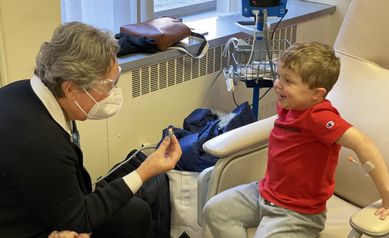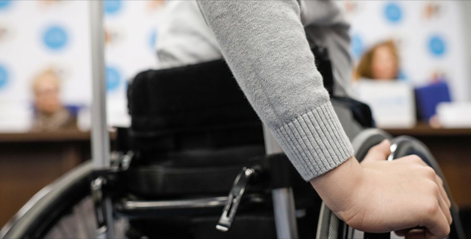News
UR Nursing Professor, Alum Earns American Heart Association Award
Tuesday, November 8, 2022
 A Doctor of Nursing Practice (DNP) alumna who led an initiative to improve the transition of ischemic stroke care from hospital to home is now being recognized nationally for her work.
A Doctor of Nursing Practice (DNP) alumna who led an initiative to improve the transition of ischemic stroke care from hospital to home is now being recognized nationally for her work.
Ann Leonhardt-Caprio, DNP, RN, ANP-BC, FAHA, program coordinator of the Comprehensive Stroke Center at Strong Memorial Hospital and an assistant professor at the School of Nursing, has been named the recipient of the American Heart Association (AHA) Council on Cardiovascular and Stroke Nursing’s 2022 Stroke Article of the Year Award.
Leonhardt-Caprio’s award-winning article, “A Multi-Component Transition of Care Improvement Project to Reduce Hospital Readmissions Following Ischemic Stroke,” was originally published in the April 2022 issue of The Neurohospitalist.
“I’m so honored to have been chosen for the Article of the Year award,” said Leonhardt-Caprio. “The fact that this work is being recognized on a national level is really special.”
Co-authors of the article include School of Nursing faculty members Craig Sellers, PhD, RN, AGPCNP-BC, GNP-BC, FAANP; Elizabeth Palermo, DNP, RN, ANP-BC, ACNP-BC; Thomas Caprio, MD, Chief Medical Officer for UR Medicine Home Care; and Robert Holloway, MD, MPH, Chair of the Department of Neurology at the University of Rochester School of Medicine and Dentistry.
Leonhardt-Caprio accepted the award over the weekend at the AHA’s Scientific Sessions in Chicago, and will also speak at the State of the Science Stroke Nursing Symposium in February.
Read More: UR Nursing Professor, Alum Earns American Heart Association AwardChildren with HIV at Greater Risk for Impaired Neurological Development
Thursday, October 13, 2022
New research in Zambia finds that children infected with HIV are significantly more likely to do worse in neurological assessments despite having well-controlled HIV disease, suggesting that they may struggle with cognitive and mental health issues. However, the research also indicates that early intervention – in the form of better nutrition and antiretroviral therapies – may help close the gap.
“HIV remains a major global health burden and children who are exposed to the virus during childbirth are known to be at greater risk for neurocognitive and psychiatric problems, like depression, as they age,” said David Bearden, M.D., assistant professor of Neurology and Pediatrics at the University of Rochester Medical Center (URMC) and senior author of the study, which appears in the Journal of Acquired Immune Deficiency Syndromes. “This research is an attempt to understand if these problems persist and become more pronounced over time, and whether we can predict who will do well cognitively and who will not.”
The study is the most recent example of a decades-long collaboration involving an international team of researchers. Since 1994, URMC neurologist Gretchen Birbeck, M.D., has partnered with the government of Zambia and clinicians and researchers with the University Teaching Hospital (UTH) in Lusaka, Zambia to study neurological problems associated with infectious diseases like HIV and malaria, which remain major public health problems in sub-Saharan Africa.
Read More: Children with HIV at Greater Risk for Impaired Neurological DevelopmentPlayer-Turned-Patient Visits Neuro-ICU
Thursday, September 15, 2022
Baseball player Daniel Brito returned to the Neuromedicine ICU on Sept. 15 to visit and thank the team who cared for him after he suffered a stroke last summer. The team saved the 23-year-old's life in July 2021 after he collapsed at Frontier Field. Members of the Neuro-ICU joined him back at the mound Thursday, where he threw the ceremonial first pitch.

Dr. Schifitto Will Explore COVID’s Potential Link to Dementia
Wednesday, August 31, 2022
There is concern in the scientific community that COVID infection may accelerate cognitive decline in older adults, resulting in a wave of dementia cases in the coming years as the population ages. A new $3.7 million grant from the National Institutes of Aging will allow researchers to more precisely understand how the virus triggers damage in the brain and the long-term impact on cognitive performance.
“Given the high rate of COVID world-wide and aging, the possible added toll to the existing burden of dementia could increase exponentially in the near future,” said University of Rochester Medical Center (URMC) neurologist Giovanni Schifitto M.D., the principal investigator of the new study. “We need to better understand the burden and progression of cognitive decline and the mechanisms by which this occurs. This will help point the way to new interventions designed to forestall the onset of dementia in these individuals.”
The new study will involve a multidisciplinary team of URMC neurologists, infectious disease experts, radiologists, and computer scientists, including Nasir Uddin, Ph.D., Meera Singh, Ph.D., Miriam Weber, Ph.D., Henry Wang, M.D., Ph.D., Hongmei Yang, Ph.D., and Angela Branche, M.D.
Several reports have highlighted the presence of cognitive and psychiatric symptoms associated with COVID infection, particularly in older adults who experienced moderate to severe infection. Other studies suggest that the COVID virus can damage the endothelial cells that line blood vessels through both direct infection and the resulting immune response.
The brain is supplied with blood by a vast network of microscopic vessels. The integrity of this microvasculature declines as we age, compromising the integrity of the blood brain barrier and leaving the brain vulnerable to infection, inflammation, and damage from the immune system. The fear is that the damage caused to blood vessels by COVID infection could speed this process up, increasing risk for cerebral small vessel disease (CSVD), which is associated with cognitive decline and ultimately dementia.
The new study will recruit 300 volunteers 65 and older who had a severe enough COVID infection that it required hospitalization, excluding individuals who required intensive care and had to be placed on a ventilator. Participants will be followed for two years with neurocognitive evaluations, advanced quantitative neuroimaging that will search for changes in white matter, blood flow, and the integrity of blood vessel, and blood biomarkers of inflammation and brain injury.
At-Home Sensors Can Spot Parkinson’s Disease
Tuesday, August 23, 2022
 A new study shows that a device that passively monitors breathing during sleep can not only detect Parkinson’s, but also track the progression of the disease over time. The researchers used an artificial intelligence tool to sift through mountains of data from study participants to find patterns that identify the disease and determine severity.
A new study shows that a device that passively monitors breathing during sleep can not only detect Parkinson’s, but also track the progression of the disease over time. The researchers used an artificial intelligence tool to sift through mountains of data from study participants to find patterns that identify the disease and determine severity.
“I like to compare our understanding of Parkinson’s to a street lamp in the night; we only get a glimpse of the disease when patients visit clinic. Moreover, the methods we use to track the disease over time are subjective,” said Ray Dorsey, M.D., a professor of Neurology at the University of Rochester Medical Center (URMC) and co-author of the study. “As a result, we have a very limited insight into how Parkinson's disease impacts people's daily lives. This study shows that remote monitoring has the potential to identify individuals with Parkinson’s and create an objective measure of severity and progression. This could be a powerful tool to detect the disease early and conduct research more efficiently.”
The research, which appears in the journal Nature Medicine, was led by Dina Katabi, Ph.D., a professor of Electrical Engineering and Computer Science at MIT. Katabi worked closely with researchers at the URMC Center for Health + Technology (CHeT), including Dorsey and Chris Tarolli, M.D., an assistant professor of Neurology. This study is one of several projects supported by CHeT that are exploring new ways to harness remote monitoring, smart phones, smart watches, and other technologies to improve care and advance research in Parkinson’s and other diseases. The study also included researchers from the Mayo Clinic, Massachusetts General Hospital, and Boston University.
Read More: At-Home Sensors Can Spot Parkinson’s DiseaseRare Brain Disorder Does Not Derail Future Career in Medicine
Tuesday, August 16, 2022

In May 2020, Rachael Muggleton was wrapping up her third year of pre-med studies at Penn State University when she unexpectedly and rapidly fell ill, victim to a rare and dangerous inflammation in the brain. She details her remarkable journey in a piece on the Neurocritical Care Society website, in which she describes her decline in health, months-long stay at Strong Memorial Hospital, and remarkable recovery.
Initially admitted to Arnot-Ogden Medical Center in her hometown of Elmira, NY, Rachael was quickly transferred to the Neuromedicine Intensive Care Unit (NMICU) at Strong, where physicians put her in a 42 day medically-induced coma to control her seizures, as a multidisciplinary team of specialists strove to calm her brain and immune system.
Rachael suffered from a rare and complex condition called autoimmune encephalitis (AE), an inflammation in the brain triggered by the body’s own immune system attacking healthy brain cells, which can result in seizures, impaired memory and cognition, and problems with balance, speech, and vision. Tests determined she had a specific type of AE characterized by the creation of antibodies that attack NMDA receptors, which reside at the connections between neurons, disrupting normal signaling between nerve cells and triggering inflammation. This form of AE is more common in women and can be associated with certain cancers, however, the source of the damaging immune response sometimes cannot be identified, as was the case with Rachael.
Read More: Rare Brain Disorder Does Not Derail Future Career in Medicine
New Grant Will Unlock Workings of Glymphatic System
Monday, August 15, 2022
A decade ago, researchers in the lab of Maiken Nedergaard, M.D., D.M.Sc., answered a basic question of biology that up to that point had eluded scientists: how is waste removed from the brain? The discovery of what is now known as the glymphatic system and subsequent research have transformed the way we study a range of neurological disorders and critical brain functions. A new $15 million grant from the National Institutes of Health (NIH) will bring together several teams of researchers to accelerate our understanding of the complex mechanics that control this system, with an eye toward the development of new therapies for diseases like Alzheimer’s.
The new research program will be led by Nedergaard, co-director of the Center for Translational Neuromedicine, and involve scientists and engineers from the University of Rochester, Penn State University, Boston University, and the University of Copenhagen. The research is being funded through The BRAIN Initiative, a massive research program supported by NIH and several other federal research agencies that aims to fill gaps in our current knowledge of the brain’s organization and function.
The glymphatic system – a network of plumbing that runs parallel to blood vessels and pumps cerebral spinal fluid (CSF) through brain tissue to wash away waste – was all but invisible to the scientific world until 2012 when it was first described in a study published in Science Translational Medicine. A paper in the journal Science a year later showed that this system operates primarily while we sleep and removes toxic proteins associated with Alzheimer’s disease. These findings fundamentally changed scientists’ understanding of the biological purpose of sleep and opened the door to potential new ways to treat neurological disorders.
Read More: New Grant Will Unlock Workings of Glymphatic SystemExperimental Gene Therapy Targets Duchenne Muscular Dystrophy
Friday, May 6, 2022
 Children in Rochester were recently among the first in the nation to receive an experimental treatment for Duchenne muscular dystrophy (DMD). The study is part of an accelerating trend of clinical trials involving gene therapies that could transform how we treat a number of devastating childhood neurological disorders.
Children in Rochester were recently among the first in the nation to receive an experimental treatment for Duchenne muscular dystrophy (DMD). The study is part of an accelerating trend of clinical trials involving gene therapies that could transform how we treat a number of devastating childhood neurological disorders.
Emma Ciafaloni, M.D., a neuromuscular neurologist with the University of Rochester Medical Center (URMC) Department of Neurology and Golisano Children’s Hospital, is leading the Rochester study site. URMC was recently one of the first three sites in the nation to start dosing patients in a phase 3 placebo-controlled clinical trial for a gene therapy being developed by Sarepta Therapeutics for children with DMD. The international study will soon add additional sites in North America, Europe, and Asia. Ciafaloni served as the chair of the independent Data Safety and Monitoring Board for the company’s early phase clinical trials of the therapy.
DMD is a condition found almost exclusively in boys and is characterized by muscle weakness, the symptoms of which often appear at a young age and progress rapidly leading to significant disability. Children with DMD typically end up in a wheelchair by age 9 or 10 because of weakness in their legs. The symptoms eventually spread to the heart and muscles responsible for breathing, and the disease is often fatal by the time the individual reaches their 20s or early 30s. An estimated 12,000 people in the U.S. suffer from the disease.
The muscle weakness associated with DMD occurs due to a genetic defect in muscle cells that impairs the production of dystrophin, an important muscle building protein that is largely absent in people with the disease. The new treatment consists of a single infusion that, via an associated adenovirus, delivers into muscle cells a separate and potentially functional “micro” version of the dystrophin gene that takes over production of the protein.
The study is the latest in a number of new gene therapies for pediatric neurological disorders that are in the developmental pipeline and have the potential to transform care and significantly reduce the burden of disease. This includes a gene therapy for spinal muscular atrophy (SMA) that was approved by the FDA in 2019. Ciafaloni was involved in the clinical trials that led to the therapy’s approval and some of the first children to receive the therapy in the U.S. were patients of the UR Medicine Pediatric Neuromuscular Medicine Program. Last year, it was announced that URMC would be the lead study site for an experimental gene therapy for CNL5 Batten disease, a rare and fatal disorder that first appears in childhood. This study is being led by pediatric neurologist Jonathan Mink, M.D., Ph.D.
In many childhood neurological disorders, spotting the disease before symptoms appear is critical for these new therapies to be effective. Ciafaloni is currently working to get Duchene added to the New York State Newborn Screening Program, a panel of medical tests that screen newborns for 50 different disorders, primarily genetic, that can be more effectively treated if identified earlier. DMD strikes early in life and the target age for the new study is 4-7 years old. In 2018, Ciafaloni, along with others in the medical community and families, successfully convinced the state to add SMA to the list of newborn tests.
Daily Steroids Safe and Slow Progression of Duchenne Muscular Dystrophy
Thursday, May 5, 2022
 New research published in JAMA recommends daily steroid doses for children with Duchenne muscular dystrophy (DMD), marking a significant change in how the disease is treated. University of Rochester Medical Center (URMC) neurologist Robert Griggs, M.D., and Michela Guglieri, M.D., with Newcastle University in the U.K., led the study, which was conducted by a global team of researchers dedicated to improving care for this fatal disease.
New research published in JAMA recommends daily steroid doses for children with Duchenne muscular dystrophy (DMD), marking a significant change in how the disease is treated. University of Rochester Medical Center (URMC) neurologist Robert Griggs, M.D., and Michela Guglieri, M.D., with Newcastle University in the U.K., led the study, which was conducted by a global team of researchers dedicated to improving care for this fatal disease.
“Corticosteroids are likely to remain the main treatment for DMD worldwide for the foreseeable future, so it is critical that we establish a standard of care that is backed by scientific evidence,” said Griggs. “This study shows that health concerns over the daily use of corticosteroids are overstated and that there is a clear benefit in terms of improved motor and pulmonary functions. These findings clearly support the daily regimen over an intermittent one as an initial treatment for boys with DMD.”
DMD is a condition found almost exclusively in boys and characterized by muscle weakness, which appears at age 3-4 and progresses rapidly, leading to significant disability. The symptoms eventually spread to the heart and muscles responsible for breathing, and the disease is often fatal by the time the boy reaches his late teens. An estimated 28,000 people in the U.S. suffer from the disease.
While corticosteroids prednisone and deflazacort are known to improve muscle strength and function in patients with DMD and have been a frontline treatment for years, there is currently no universally accepted standard for steroid use in DMD. A global survey of physicians who treat DMD found 29 different regimens, with the most common being ten days on and ten days off. This intermittent dosing regimen was put in place in an effort to limit the potential side effects associated with prolonged steroid use in children, such as weight gain, stunted growth, and loss of bone density.
The Finding the Optimum Regimen of Corticosteroids for DMD (FOR-DMD) study was launched in 2013 to compare daily and intermittent steroid use and establish, from a clinical benefit and safety perspective, the most beneficial regimen for DMD patients. Griggs and Kate Bushby, M.D., with Newcastle University initiated the phase 3 clinical trial conducted through the Muscle Study Group, an international network of muscular dystrophy researchers that Griggs helped create in 1997 to advance clinical research in neuromuscular disorders, including DMD.
Documentary Sheds Light on the Parkinson’s ‘Pandemic’
Wednesday, May 4, 2022
 A new documentary, titled The Long Road to Hope, tells the story of individuals with Parkinson’s and efforts to study, treat, and prevent the disease from a global perspective.
A new documentary, titled The Long Road to Hope, tells the story of individuals with Parkinson’s and efforts to study, treat, and prevent the disease from a global perspective.
The documentary was produced by the University of Rochester Center for Heath + Technology (CHeT) and features 12 Parkinson’s patients from the U.S., Canada, the U.K., and the Netherlands and medical commentary from University of Rochester Medical Center neurologist Ray Dorsey, M.D., and Bas Bloem, M.D., Ph.D., with Radboud University Medical Center in the Netherlands.
Parkinson's disease is the fastest growing neurological disorder in the world, outpacing Alzheimer’s, and can be triggered by exposure to pesticides and industrial chemicals. Dorsey and Bloem discuss the pandemic scope of this largely preventable disease and how addressing it will require a global effort with the same level of focus and resources employed with success to address other public health challenges, such as polio, HIV, and breast cancer.
Read More: Documentary Sheds Light on the Parkinson’s ‘Pandemic’Heatwole Appointed Director of CHeT
Wednesday, April 27, 2022
Chad Heatwole, M.D., M.S., has been appointed the new director of the Center for Health + Technology (CHeT) at the University of Rochester. Selected through a national search process, Heatwole took over on a permanent basis on April 25 from Ray Dorsey, M.D., who led the Center since 2013.
“CHeT has a proud history dating back 35 years and has played a leading role in the study and approval of many of the drugs we use today to treat Parkinson’s and other neurological diseases,” said Bob Holloway, M.D., chair of the URMC department of Neurology. “More recently, under Ray’s leadership CHeT has become a pioneer in deploying technologies to improve remote access to specialized care and allow broader participation in clinical research. Chad is well-positioned to lead CHeT into the next chapter and bring patients and communities – across a range of diseases – more into the center of what we do and become true partners in the development of future therapeutics.”
“Chad has played a pivotal role in our Neuromuscular Disease Center, particular the study of myotonic dystrophies, which is recognized as one of the top programs in the world,” said Mark Taubman, M.D., CEO of URMC and dean of the University of Rochester School of Medicine and Dentistry. “He has helped create a robust infrastructure to support clinical trials, which has been instrumental in the growth of the neuromuscular program and we look forward to extending these efforts across the Medical Center, under CHeT. I also want to thank Ray for his transformative leadership and creating a strong foundation which will ensure that CHeT thrives under Chad’s guidance.”
Read More: Heatwole Appointed Director of CHeTArticle Details Baseball Player’s Road to Recovery after Devastating Brain Injury
Monday, February 14, 2022
On July 31 last year, Daniel Brito, third basemen for the Lehigh Valley Iron Pigs, had just taken the field in the bottom of first inning during the first game of a planned double header against the Rochester Red Wings when the unthinkable happened. A tangle of abnormal blood vessels – called an arteriovenous malformation (AVM) – burst in his brain and triggered a seizure. Brito collapsed in the infield, the game was halted, an ambulance was brought onto the field, and he was rushed to UR Medicine’s Strong Memorial Hospital.
While those frightening scenes at Frontier Field were reported by the media, the full story of what occurred that day and Brito’s remarkable journey to recovery from a dangerous and potentially deadly brain injury is only now being fully told in a story appearing in The Athletic.
“Everything that happened to Daniel felt like it was one in a million,” said Debra Roberts, M.D., the director of the UR Medicine Neuromedicine Intensive Care Unit which was Brito’s home for almost two months as he recovered from the damage caused to his brain. “A million in one chance he is born in Venezuela and becomes a professional baseball player. And a million in one chance that he both has an AVM and that it ruptures.”
AVMs are rare, can form at a very young age, and frequently go undetected until it triggers dizziness, headaches, or seizures, which result in the AVM being identified in brain scans and medically managed or surgically removed. While ruptures are rare, occurring in roughly two percent of people with an AVM annually, the consequences can be severe, both in terms of damage to nearby brain tissue, but also the pressure that the bleeding and buildup of fluids puts on the brain. The stress response triggered in the body can also sometimes lead to complications with other organs as the body fights for survival.
Read More: Article Details Baseball Player’s Road to Recovery after Devastating Brain InjuryResident Interviews
Tuesday, February 1, 2022
The Department of Neurology would like to welcome residency applicants, interviewing on Monday, January 9th
Adult Neurology Applicants
Abhilasha Boruah – Case Western Reserve University
Julia Iourinets – Loyola University
In (Josh) Kang – Georgetown University
Aaron Kuang – SUNY Downstate Health Sciences University
Casey Manzanero – SUNY Upstate Medical University
Alexander Mathew – University of Virginia
Sarah Wang – Albert Einstein College of Medicine
Child Neurology Applicants
Destiny Bailey – University of Texas Southwestern Medical School
Hosain Ghassemi – University of Kansas SOM
Colin Huang – University of California San Francisco SOM
Delia Rospigliosi – Baylor COM
Pablo Vazquez – Tufts University SOM